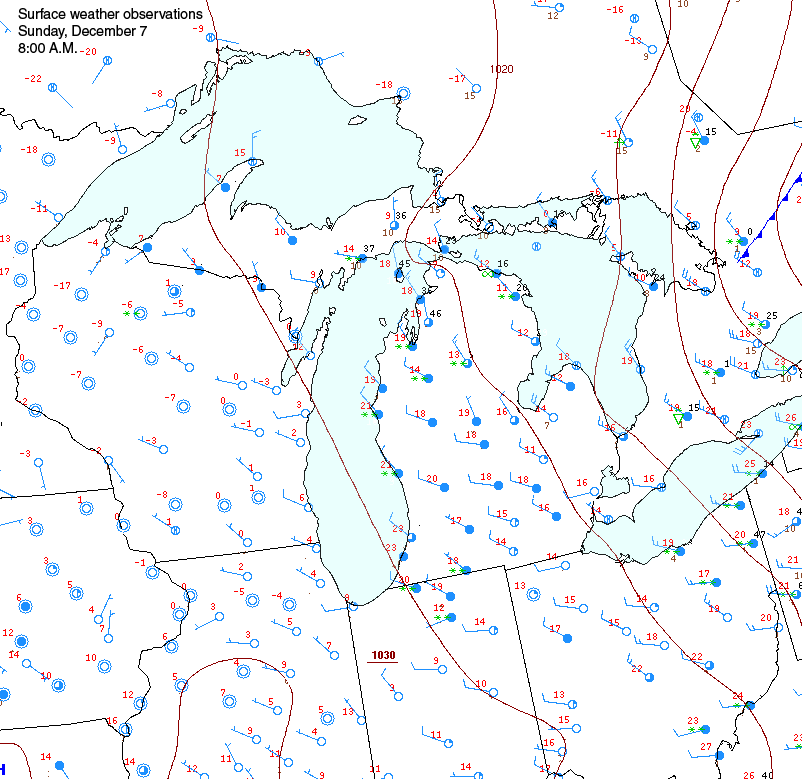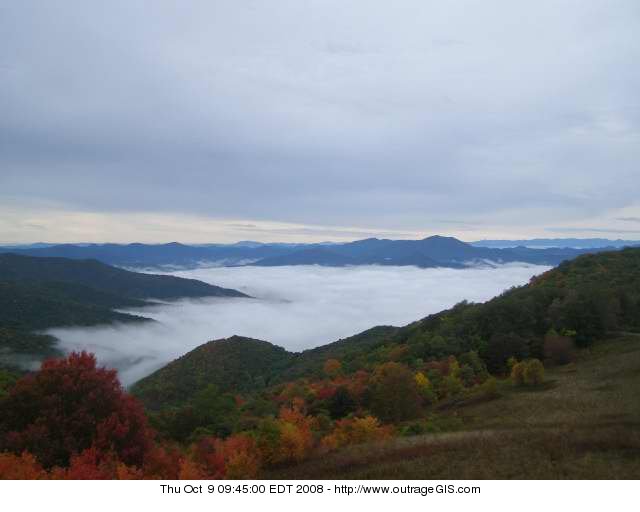The trails in the Big South Fork are were not impacted by the ice storm that hit the northern portions of the Daniel Boone National Forest. Hikers have reported excellent trail conditions, though fording Rock Creek or the Big South might be a little cold and water levels high this time of year.
Trail conditions in Cave Run Lake
Trails in the Cave Run area survived the recent ice storm, though vandalism at Tater Knob Fire Tower seriously damaged the tower. Some individual(s) set fire to the structure and it is now closed. Please contact the U.S. Forest Service if you have information about this act of arson.
Trail Conditions after the Ice Storm
The Red River Gorge was impacted by the January ice storm. The gravel FS roads were closed for about a week, but they are now open. All of the trails in the Red River Gorge proper have been cleared of debris, except Courthouse Rock Trail, Rough Trail over Parched Corn Creek, and the Sheltowee Trace north of Bison Way. Trails in the Clifty Wilderness has not been cleared, and since no chainsaws are allowed there, it might take time to clear.
The debris is problematic, but not a deal breaker in my opinion. Though if you are backpacking and/or have leashed dogs, a down tree on the trail is problem. I went out Swift Camp Creek east of 715 for about a mile and the trail was not that bad. As with any backcountry adventure, you’ll expect an element of danger so please use an extra measure of caution on trails in the Clifty Wilderness…and tell us how they are!
Boyd
Winter Storm in the Bluegrass
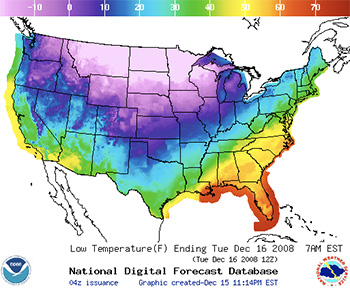 Winter storm warning, Dec 15-16, 2008.
Winter storm warning, Dec 15-16, 2008.
“The National Weather Service will issue a winter storm warning when a dangerous combination of heavy snow, with sleet and/or freezing rain, will occur or has a high probability of occurring within the next 12 hours.”
Severe winter weather events are notorious to forecast. Our TV weathercasters had a range of predictions from a half-inch of ice accumulation to 5 inches of snow. The National Weather Service (NWS) had a similar forecast. After the event, we had a lot of variability across the region, so in part, all of the predictions were somewhere correct. I think the NWS made a good prediction on where the bad weather would happen, but the severity was hard to calculate.
The above map (shown in greater detail below) shows low temperatures across the U.S. and highlights the problem with forecasting such a large storm. The huge temperature change from -20° F in the northern states to 60° F in the southeast indicates two vastly different air masses in close proximity. The greater the difference, the more difficult the predictions. When the air masses begin to interact and do their dance, that’s the problem.
It’s easy to forecast calm conditions, but when the weather becomes bad, the severity is determined by how different the air masses are and how much they interact. Two similar air masses doing a “big dance” will have little impact. Two vastly dissimilar air masses just interacting slightly will produce enormous weather. Though we can measure the characteristics of air masses, the problem is that we can’t predict how they’ll interact.
The basic setup we had here was that cold polar plunged southward, and displaced the warmer, more moist tropical air. As the warmer, less dense air rode over the advancing colder, denser air, precipitation fell as rain. As it traveled through the colder, ground layer of air, it froze on surface contact. That’s freezing rain. However when upper layer of air approaches the freezing point, precipitation could fall as snow or sleet. As this boundary zone between air masses changes, the vertical temperature profile changes and so does the type precipitation that hits the ground.
Can you feel it for the weathercaster trying to predict this stuff?
Watches and Warnings Map, Dec 16
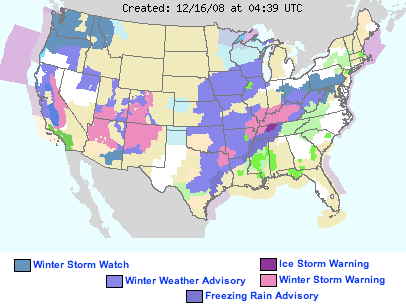
Above map is the Watches and Warnings for the U.S., December 16, 2008. Compare this map to the below map, which forecasts low temperatures for this morning. Note the axis of warnings from Texas to Pennsylvania which overlays a sharp temperature contrast between the polar air to the northwest and tropical air to the southeast. This steep temperature gradient is almost 90° F and is zone of interaction.
Low Temperature Map, Dec 16

The below map shows snow and ice totals for the Bluegrass region.
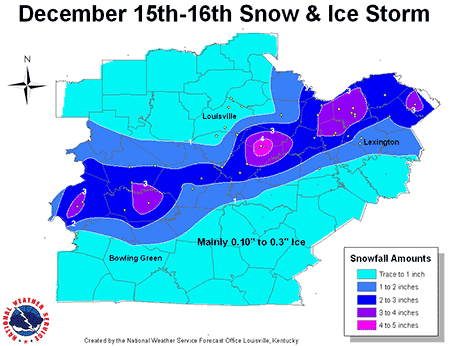
Sunday Wind Advisory
![]() Wind advisory, Sunday Dec 14, 2008
Wind advisory, Sunday Dec 14, 2008
The National Weather Service will issue a wind advisory for sustained winds 31 to 39 mph for at least 1 hour or any gusts 46 to 57 mph. However, winds of this magnitude occurring over an area that frequently experiences such winds would not require the issuance a wind advisory.
Lexington recorded sustained winds of 39 mph with gusts around 45 mph. This created difficult walking conditions at times around downtown. Wind speeds can be faster in isolated parts of the built environment because of turbulence. Though cities typically decrease average wind speeds near ground level, during periods of high wind speed tall buildings interrupt flow causing them to ‘pile up’ on windward sides and then rush off with increased velocity in channels between buildings. Wind eddies on the leeward side of buildings will also have strong gusts.
A comparison to a simple stream might be helpful. Water flows fastest in the stream’s center. An obstruction blocking the stream will divert the flow into two channels, each with increased velocity. Unlike water though, air can be highly compressed. When air piles up on the windward or upstream side, it will move in a more dynamic manner around the obstruction. Turbulence.
The mechanics of how all this plays out is beyond my understanding, but it is sufficient to say that when a wind advisory is issued for Lexington, we can experience strong and erratic winds downtown. I noticed many flocks of pigeons remaining on their protective perch, and no soaring hawks or vultures, so that’s probably a good gauge of strong turbulence.
The last time the area was under a wind advisory was during the passing of the remnants of Hurricane Ike. I think winds gusted to near-hurricane strength. Winds this weekend are associated with a strong low that passed to our north. This low pressure system created blizzard conditions and wind chill warnings across the northern states. The system also brought the cold punch of air that created our first major winter storm a day later.
The chart below is from the Beaufort Scale of wind speed. So next time you’re wondering, “What’s that wind speed?” here’s your chart.
| Description | Speed | Visual Clues and Damage Effects |
|---|---|---|
| Calm | Calm | Calm wind. Smoke rises vertically with little if any drift. |
| Light Air | 1 to 3 mph | Direction of wind shown by smoke drift, not by wind vanes. Little if any movement with flags. Wind barely moves tree leaves. |
| Light Breeze | 4 to 7 mph | Wind felt on face. Leaves rustle and small twigs move. Ordinary wind vanes move. |
| Gentle Breeze | 8 to 12 mph | Leaves and small twigs in constant motion. Wind blows up dry leaves from the ground. Flags are extended out. |
| Moderate Breeze | 13 to 18 mph | Wind moves small branches. Wind raises dust and loose paper from the ground and drives them along. |
| Fresh Breeze | 19 to 24 mph | Large branches and small trees in leaf begin to sway. Crested wavelets form on inland lakes and large rivers. |
| Strong Breeze | 25 to 31 mph | Large branches in continuous motion. Whistling sounds heard in overhead or nearby power and telephone lines. Umbrellas used with difficulty. |
| Near Gale | 32 to 38 mph | Whole trees in motion. Inconvenience felt when walking against the wind. |
| Gale | 39 to 46 mph | Wind breaks twigs and small branches. Wind generally impedes walking. |
| Strong Gale | 47 to 54 mph | Structural damage occurs, such as chimney covers, roofing tiles blown off, and television antennas damaged. Ground is littered with many small twigs and broken branches. |
| Whole Gale | 55 to 63 mph | Considerable structural damage occurs, especially on roofs. Small trees may be blown over and uprooted. |
| Storm Force | 64 to 75 mph | Widespread damage occurs. Larger trees blown over and uprooted. |
| Hurricane Force | over 75 mph | Severe and extensive damage. Roofs can be peeled off. Windows broken. Trees uprooted. RVs and small mobile homes overturned. Moving automobiles can be pushed off the roadways. |
Weather influenced by the Great Lakes
One of the most obvious and striking winter weather conditions is the atmospheric influence of the Great Lakes. When high pressure builds to the west of the Great Lakes and there’s a prominent northwest-to-southeast surface wind flow, weather is significantly different downwind of the lake compared to upwind. This often produces lake effect snow that can truly bury southeastern shore cities. However, the same influence can reach far south into Kentucky and the Appalachians.
The difference in weather can be outstanding, as people who live near the lakes know very well. Observe weather on both sides of Lake Michigan. The red number indicates the temperature in °F and the circle indicates cloud cover. A solid circle is completely cloudy, and an empty circle represents clear skies. The barb indicates wind speed and direction (see below for legend).
Compare Lake Michigan’s west shore with its east shore. The west shore of Lake Michigan is cold, below zero, and cloudless. Weather on the east shore of Lake Michigan is 20°F warmer, it is cloudier, and snow is falling, as represented by the green asterisks.
The cause of these conditions is simply the great reservoir of heat that the lakes contain and transfer to the atmosphere through evaporation. Though the lakes are slowly cooling through winter, they are significantly above freezing across a large area. When a colder, dry air mass blows over the lakes, evaporation will transfer heat and moisture into the air mass. As the rising, warmer air cools, if often condenses resulting in cloudiness and heavy snow; the lake effect snow machine. Also note the how far south the warmer air has penetrated compared to other locations at the same latitude.

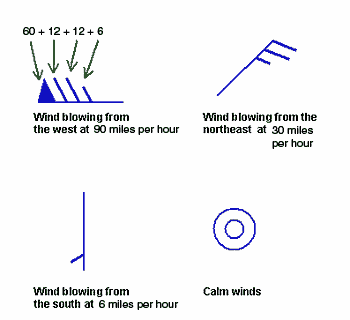
For example this station here:  is reporting that the current temperature is 55 degrees F, the sky is clear, and the winds are blowing from the north at 18 miles per hour.
is reporting that the current temperature is 55 degrees F, the sky is clear, and the winds are blowing from the north at 18 miles per hour.
And this station  is reporting completely overcast conditons, winds from the north at 24 miles per hour and the temperature is 58 degrees F.
is reporting completely overcast conditons, winds from the north at 24 miles per hour and the temperature is 58 degrees F.
Sundog over Lexington

This sundog occurred Friday night over Lexington and there is a companion sundog to the left, but it is out of the frame. The bright spot to the far right is a reflection off our “Big Blue” building.
Sundogs form when a couple unique conditions are present. Cirrus clouds are the atmosphere’s highest clouds and are composed of small ice crystals. These ice crystals are were the sun creates the show.
When the sun is close to the horizon and there’s a significant layer of cirrus clouds, which should be noted are curving towards the horizon, sunlight will do 3 things: 1) be reflected at a predictable location causing the bright spot, 2) refracted at the same spot causing a rainbow, and 3) scattered throughout giving the sundog a general reddish cast.
While not rare, sundogs are uncommon and have been heralded as both good and bad omens by ancient peoples.
Morning in the Great Smokies
Fog below Purchase Knob on the morning of October 9, 2008
Pine Mountain Trail in the New York Times
October 3, 2008
Excerpt: “THIS is all virgin trail,†said Shad Baker, a connoisseur of hiking in the steeply slanted backwoods of eastern Kentucky, as he dropped me off at the start of my adventure there on the new Pine Mountain Trail. “This is probably the most remote place you can get that exists out here. You are five miles even from the nearest house.â€
We said goodbye. He drove off. And then I slipped into woods so thick they looked like an American jungle.
It was only a year or two ago that the high-ridge forests of Pine Mountain, at the western edge of the Appalachians, were for all practical purposes sealed off by their own forbidding density and ruggedness — impenetrable to everyone but ginseng harvesters and squirrel hunters. This is Daniel Boone country, and as I set out that morning it was easy to imagine Boone hacking his way through it with a homemade hatchet and a long flintlock firearm. But I had markers to follow — squares of pale-yellow painted on trees at eye level…”
Read full article at New York Times:
http://travel.nytimes.com/2008/10/03/travel/escapes/03pine.html

 Pine Mountain Trail Map
Pine Mountain Trail Map
Difficulty: ++++
Scenic Views: +++
Elevation Relief: 2,100ft ^^^
Ownership: Private, Kentucky SP, Jefferson NF
Google to Elkhorn City trailhead
photos by Boyd Shearer
Cave Run Lake Trail Conditions
 Awesome. That’s the a good word to describe the current trail conditions at Cave Run. Often plagued with muddy trail conditions from numerous seeps, the trails now are fast, firm, and fantastic. Trails around sandstone outcroppings are sandy as usually and the soil elsewhere is dusty.
Awesome. That’s the a good word to describe the current trail conditions at Cave Run. Often plagued with muddy trail conditions from numerous seeps, the trails now are fast, firm, and fantastic. Trails around sandstone outcroppings are sandy as usually and the soil elsewhere is dusty.
Water is an issue for backcountry ridge campers. Clear Creek is not flowing at the Iron Furnace. Occasional pools are found with plenty of crawdads and water spiders, but above that nothing. Of course the lake has plenty of water, but one will have to climb off the ridge to refill their nalgenes.
For more info about the drought conditions the forest is experiencing, visit our post on this topic here.
Drought Conditions in the Daniel Boone
 Precipitation, or lack thereof.
Precipitation, or lack thereof.
The Daniel Boone National Forest averages between 43 inches a year in the northeastern section to 53 inches in the southwestern section around the Big South Fork. Currently, the forest is in a precipitation deficit of around 4-8 inches. With the approaching fall and the driest period of the year, the forecast is for a seriously dry time in the woods. This is especially true to south and east, but the high ridges are dust dry now.
The most problematic aspect of a drought this time of year is forest fire hazards. After trees drop their leaves under cloudless skies, the forest floor experiences direct sunlight and high evaporation rates. This produces abundant fuel for forest fires.
So if you’re planning a trip this autumn, be careful with camp fires and consider using stoves for cooking and battery candles for illumination. The following discussion looks at national maps of drought severity and outlook.
Red River Gorge Trail Conditions
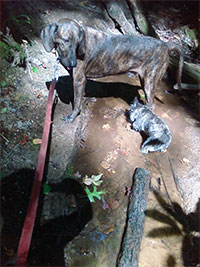 Red River Gorge trails are fantastic right now. This late September season has given us clear, warm days and dry, cool nights. The waning moon is glowing through high cirrostratus that are hinting rain, but none is in the forecast.
Red River Gorge trails are fantastic right now. This late September season has given us clear, warm days and dry, cool nights. The waning moon is glowing through high cirrostratus that are hinting rain, but none is in the forecast.
The high pressure that has cleared our skies and dried out our humidity, is an extensive mass of subsiding air that is evaporating any encroaching low level moisture. In the late afternoon, you’ll see some isolated cumulus clouds develop, but are stunted from any vertical growth. No rain to parch your throat.
Drought is a serious concern in the following weeks. Martin’s Fork at the head of D Boone hut is following about a gallon/minute. This groundwater will eventually drain out leaving vacant streams beds in the mid and upper reaches of hollows.The advice is get on the trail now or pray for rain in October. For more info and maps on the current drought, look at our post on this topic.
Hurricane Ike
Postscript
Ike’s precipitation never made it to the Daniel Boone. The winds did however. Hurricane force winds were recorded in Louisville, Kentucky and a strong wind advisory was posted for Lexington and the Daniel Boone. We’ll have to wait and hope for another storm to bring much needed rain to the state, though we wish for no dangerous hurricane.
Current Track for September 11
It was 47 years ago today that Hurricane Carla made landfall and battered the central Texas coast with wind gusts to 175 mph, and up to 16 inches of rain. Carla also spawned a tornado which swept across Galveston Island killing eight people. The Category 4 hurricane claimed 45 lives and caused $2.22 billion dollars in damage.
Forecasters haven’t directly compared Ike to Carla yet, but this hurricane will most likely impact Kentucky. After making landfall Friday, Ike should swing northest north and aim for Kentucky and the Daniel Boone National Forest. The final track however has yet to play out, but if the bluegrass gets under this tropical depression, the state undoubtedly will do some catching up on the meager precipitation it has received this summer.
On average, the central part of the state receives about 11 inches of rain in the summer, however only 8 inches has fallen from June-August and none so far in September. In September, one of the bluegrass’s driest months, rainfall totals average about 3 inches. Last September, less than one inch of rain fell that month. Bone dry.
 Enter Ike
Enter Ike
A storm of this magnitude could definitely bring 3 inches of rain to the bluegrass. It could bring 6 inches. If it strengthens to a category 4 storm above the warmest section of the Gulf of Mexico as predicted, it will contain an enormous amount of energy and water vapor. Hurricanes this strong produce more energy in a day than the U.S. produces at all power plants in a year. That’s a lot of juice and Ike has to go somewhere.
Hurricanes need over 80-degree F surface water temperatures to exist. Every degree above that is like adding gasoline to a fire.
Below is a map of current surface water temperatures
![]()
Bike Prom 2008
 Lexington’s First-ever 2008 Bike Prom!
Lexington’s First-ever 2008 Bike Prom!
September 6, 6:00 PM
Fundraiser for The Living Arts and Science Center.
Postscript: The prom was tremendous with 96 gorgeous riders and tons of fun at the afterparty. Photographs can be found at the Forum discussion on Lexrides.com.
The Event. Dress up and Dance your bike around downtown Lexington during the 2008 Bike Prom. Ride stag or bring a date. No prior prom experience required, just bring your bike, share your fun-loving attitude, and promenade your style in the city.
What will you do on your special night? You will ride to selected destinations with a provided map and stamp your dance card at each location. You will asked to perform prom activities at each dance stop, such as be fitted with a supplied corsage, primp at the glitter station, partake and properly toast from the magic punch bowl (adult and child versions provided), select just the right tune, take a whirl on the dance floor, and have your photograph made with a backdrop of stardust and rocket ships.
While prom activities will be easy and fun to complete, you might find a few bike-related challenges that will spice up your night. All destinations and activities will be provided on the map and dance card.
Prizes and Afterparty. In the euphoria of the evening, maybe you’ll get lucky and the win the coveted crown of the Prom King or Queen. As you grace us with your cosmic moves on the dance floor, remember style is more significant than speed. Prizes for best-dressed couple and best-dressed male and female. We reserve the right to offer mystery prizes too. Prizes will be awarded during the after party at Molly Brooke’s Irish Bar with drink specials and DJ music by local mix-meister Mick Jeffries.
Start Time and Place. The prom starts at the Living Arts & Science Center, 362 N. Martin Luther King Blvd., Lexington, Ky. Registration begins at 6:00 PM and the dance starts at 6:30 PM. Rain date is the following Saturday, September 13. The event is $5.00 and all proceeds benefit the Living Arts & Science Center. The event is open to the public.
Sponsors. Proudly sponsored by following local businesses: outrageGIS mapping, Isle of You, Pedal the Planet, The Morris Book Shop, Molly Brooke’s Irish Bar, The Hive, and CD Central.
Hope to see you there!
Woodland Arts Fair, Aug 16-17
![]() A postscript on the event: Thanks for all those trail lovers who showed up and visited our booth. We met many outdoor enthusiasts with great trip stories. For folks who walked away with great coupons and discounts, the store is open. If you couldn’t make it out and still want those deep discounts, just register for our newsletter and you’ll get a new round of superb coupons and map specials the first of September.
A postscript on the event: Thanks for all those trail lovers who showed up and visited our booth. We met many outdoor enthusiasts with great trip stories. For folks who walked away with great coupons and discounts, the store is open. If you couldn’t make it out and still want those deep discounts, just register for our newsletter and you’ll get a new round of superb coupons and map specials the first of September.
Once again we are participating in the Woodland Arts Fair in Lexington, Kentucky. The event runs typically from 10am-6pm on Saturday and 12pm-5pm on Sunday. We’ll back in the shady section, the bottom of the U, in the Woodland Christian Church Annex.
We’ll have all of our maps, which will include special, one-time free downloads of the GPS data packs and discount coupons only available during the fair. We’ll also have a cotton candy machine and free lama rides, no we won’t!, but other booths will have said treats and activities. Nearby our booth is Cricket Press, who makes some of the most attractive screen printing ephemera and t-shirts you’re gonna find in the Bluegrass.
Hope to see you there!

